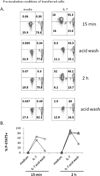Recycled IL-7 Can Be Delivered to Neighboring T Cells
- PMID: 25870237
- PMCID: PMC4417450
- DOI: 10.4049/jimmunol.1400560
Recycled IL-7 Can Be Delivered to Neighboring T Cells
Abstract
IL-7 is a key homeostatic cytokine that provides signals for T cell survival and proliferation in vivo. In this article, we provide evidence that IL-7 utilization is enhanced by a novel mechanism of cytokine "recycling" during which T cells treated with rIL-7 are rapidly induced to express p-STAT5 and are subsequently able to recycle biologically active cytokine for release to neighboring cells in soluble form. Our observations indicate that the ability of cells to recycle IL-7 is dependent on IL-7R α-chain (CD127) and endocytosis, consistent with a model whereby IL-7 is internalized via receptor interactions before recycling. These observations provide evidence of a novel mechanism that enables cells to optimally use IL-7.
Copyright © 2015 by The American Association of Immunologists, Inc.
Figures








Similar articles
-
Synergistic effects of IL-7 and IL-12 on human T cell activation.J Immunol. 1995 May 15;154(10):5093-102. J Immunol. 1995. PMID: 7730615
-
IL-7 and the HIV Tat protein act synergistically to down-regulate CD127 expression on CD8 T cells.Int Immunol. 2009 Mar;21(3):203-16. doi: 10.1093/intimm/dxn140. Epub 2009 Jan 15. Int Immunol. 2009. PMID: 19147839
-
Chimeric γc cytokine receptors confer cytokine independent engraftment of human T lymphocytes.Mol Immunol. 2013 Nov;56(1-2):1-11. doi: 10.1016/j.molimm.2013.03.021. Epub 2013 Apr 27. Mol Immunol. 2013. PMID: 23628622
-
IL-7 signaling and CD127 receptor regulation in the control of T cell homeostasis.Semin Immunol. 2012 Jun;24(3):209-17. doi: 10.1016/j.smim.2012.04.010. Epub 2012 May 1. Semin Immunol. 2012. PMID: 22551764 Free PMC article. Review.
-
Exploiting differential expression of the IL-7 receptor on memory T cells to modulate immune responses.Cytokine Growth Factor Rev. 2014 Aug;25(4):391-401. doi: 10.1016/j.cytogfr.2014.07.012. Epub 2014 Jul 29. Cytokine Growth Factor Rev. 2014. PMID: 25130296 Review.
Cited by
-
IKAROS in Acute Leukemia: A Positive Influencer or a Mean Hater?Int J Mol Sci. 2023 Feb 7;24(4):3282. doi: 10.3390/ijms24043282. Int J Mol Sci. 2023. PMID: 36834692 Free PMC article. Review.
-
Targeting Cytokines in GVHD Therapy.J Immunol Res Ther. 2017;2(1):90-99. Epub 2017 Jun 28. J Immunol Res Ther. 2017. PMID: 28819653 Free PMC article.
-
Dysbiosis of lower respiratory tract microbiome are associated with proinflammatory states in non-small cell lung cancer patients.Thorac Cancer. 2024 Jan;15(2):111-121. doi: 10.1111/1759-7714.15166. Epub 2023 Dec 2. Thorac Cancer. 2024. PMID: 38041547 Free PMC article.
-
Transcriptional Regulation of Genes by Ikaros Tumor Suppressor in Acute Lymphoblastic Leukemia.Int J Mol Sci. 2020 Feb 18;21(4):1377. doi: 10.3390/ijms21041377. Int J Mol Sci. 2020. PMID: 32085659 Free PMC article. Review.
References
-
- Giliani S, Mori L, de Saint Basile G, Le Deist F, Rodriguez-Perez C, Forino C, Mazzolari E, Dupuis S, Elhasid R, Kessel A, Galambrun C, Gil J, Fischer A, Etzioni A, Notarangelo LD. Interleukin-7 receptor alpha (IL-7Ralpha) deficiency: cellular and molecular bases. Analysis of clinical, immunological, and molecular features in 16 novel patients. Immunol Rev. 2005;203:110–126. - PubMed
Publication types
MeSH terms
Substances
Grants and funding
LinkOut - more resources
Full Text Sources
Other Literature Sources
Molecular Biology Databases
Miscellaneous

